By Vicki Matranga, Design Programs Coordinator
Learn how to develop and launch the right products for the right customer—with the right methods! Be sure to attend some of the free executive-level educational sessions at the Innovation Theater. These programs will give you a fresh perspective as you walk the Show and will inspire, inform and improve your business.
The four days of the 2015 International Home + Housewares Show will be packed with events and educational sessions. To help you plan your valuable time at the Show, in these final days before the Show begins, we preview a few of the 21 presentations that will take place in the Innovation Theater in the Lakeside Center. Don’t miss the chance to meet the speakers in person and the opportunity to ask questions relevant to your work. All programs are audio-recorded and will be available on www.housewares.org after the Show.
The IoT at Home: Creating a Compelling Ecosystem for the Internet of Things
Sunday March 8 12:30—1:20 p.m.
Innovation Theater, Lakeside Center, Room E350
As the Internet of Things becomes more tangible for consumers and more household products become “smart”—what does that mean for traditional housewares manufacturers and retailers? Learn about the challenges companies face in creating these smart devices and bringing them to market. This panel will focus on trends in the rapidly evolving smart home market and its impact on the housewares industry. Panelists include Keith Barry, reviewed.com, Ian Swanson, DataScience; Mike Fretwell, Jarden Consumer Solutions; Peter Taylor, Belkin International/WeMo and Matt McGovren, Wink.
Today we are speaking with Keith Barry, Ian Swanson, Matt McGovren and Peter Taylor.
 Panel moderator Keith Barry is editor-in-chief of home and auto at Reviewed.com, a division of USA Today. Reviewed.com conducts standardized, lab-based tests of home appliances and consumer electronics from facilities in Cambridge, Mass., and extensively covers new technology for the home, including smart appliances and connectivity. Keith has also written for Wired, Car and Driver, CityLab, and the Boston Globe. Ian Swanson, CEO, DataScience, formerly known as Connect HQ, is an expert in Big Data and analytics, an accomplished entrepreneur and a successful executive for such Fortune 500 companies as American Express and Sprint. Ian is at home in both startups and enterprise-level organizations. He founded Sometrics, which launched the industry’s first global virtual currency platform in 2008 and was acquired by American Express in 2011. That platform — for which he earned a patent — managed more than 3.3 trillion units of virtual currency and served an online audience of 250 million in more than 180 countries. Prior to Sometrics, Ian worked for the secure chat and messaging startup, Userplane, which was subsequently acquired by AOL.
Panel moderator Keith Barry is editor-in-chief of home and auto at Reviewed.com, a division of USA Today. Reviewed.com conducts standardized, lab-based tests of home appliances and consumer electronics from facilities in Cambridge, Mass., and extensively covers new technology for the home, including smart appliances and connectivity. Keith has also written for Wired, Car and Driver, CityLab, and the Boston Globe. Ian Swanson, CEO, DataScience, formerly known as Connect HQ, is an expert in Big Data and analytics, an accomplished entrepreneur and a successful executive for such Fortune 500 companies as American Express and Sprint. Ian is at home in both startups and enterprise-level organizations. He founded Sometrics, which launched the industry’s first global virtual currency platform in 2008 and was acquired by American Express in 2011. That platform — for which he earned a patent — managed more than 3.3 trillion units of virtual currency and served an online audience of 250 million in more than 180 countries. Prior to Sometrics, Ian worked for the secure chat and messaging startup, Userplane, which was subsequently acquired by AOL.
 Mike Fretwell is the vice president and general manger of the home Environment, bedding and wellness team at Jarden Consumer Solutions. Mike has held several positions in both sales and marketing for the Nabisco Biscuit Company and Applica Consumer Products (a Black & Decker licensee). At Jarden, Mike has led the Mr. CoffeeTM team, the Crock-PotTM team, as well as the OsterTM blending business. Currently he is the executive sponsor of the Internet of Things for Jarden Consumer Solutions, focusing on connected home and connected health.
Mike Fretwell is the vice president and general manger of the home Environment, bedding and wellness team at Jarden Consumer Solutions. Mike has held several positions in both sales and marketing for the Nabisco Biscuit Company and Applica Consumer Products (a Black & Decker licensee). At Jarden, Mike has led the Mr. CoffeeTM team, the Crock-PotTM team, as well as the OsterTM blending business. Currently he is the executive sponsor of the Internet of Things for Jarden Consumer Solutions, focusing on connected home and connected health.
 Peter has spent more than 10 years in the connected home space in marketing, user experience, product development and sociology around shared products in the family home. He oversees the Jarden relationship and leads a team that launched eight Smart Home products last year including Crock-Pot® Slow Cooker, Mr. Coffee, three Holmes Home Environment products, WeMo and Osram LED lights and WeMo Maker.
Peter has spent more than 10 years in the connected home space in marketing, user experience, product development and sociology around shared products in the family home. He oversees the Jarden relationship and leads a team that launched eight Smart Home products last year including Crock-Pot® Slow Cooker, Mr. Coffee, three Holmes Home Environment products, WeMo and Osram LED lights and WeMo Maker.
What is the most exciting or rewarding part of your job? What inspires your passion in your work?
Keith: The most rewarding part of my job is sharing new technology with our readers, and explaining how simple innovations could make their lives easier.
 Ian: Tackling some of the formidable challenges that confront and confound businesses across the board. Companies are experiencing an explosion of data, truly big data. Data is multiplying every year in quantity and by type. Whether you make garage doors or coffee makers or anything else, the market is drowning in data. The key thing to understand in order to stay competitive is the need to extract value from that data. Any company that wants to lead its market, or keep market share, needs to get value from its data. You can’t just sit on it. Why? Because your competition is likewise trying to get value from its data.
Ian: Tackling some of the formidable challenges that confront and confound businesses across the board. Companies are experiencing an explosion of data, truly big data. Data is multiplying every year in quantity and by type. Whether you make garage doors or coffee makers or anything else, the market is drowning in data. The key thing to understand in order to stay competitive is the need to extract value from that data. Any company that wants to lead its market, or keep market share, needs to get value from its data. You can’t just sit on it. Why? Because your competition is likewise trying to get value from its data.
Matt: The industry is growing and evolving at a record pace. It’s really exciting to see the promise of the smart home now becoming a reality and to be working at a company that’s helping lead the charge toward making the smart home accessible for everybody.
Peter: Spending time with connected home users in their homes and understanding the frustrations, happy moments, gaping holes and the “ah-ha” moments.
In the past few years, what has changed most in your business? How has your company met these challenges in the way you do your work?
Keith: The rapid proliferation of new smart products has been remarkable. Only now are we starting to see consumer-facing standards that will make it easier for customers to adopt these new technologies in their own homes.
Ian: As our name indicates, we’re a data science company. We deliver what customers need to see in their data – actionable insights, not more dashboard reports. In the simplest terms, data science is the extraction of knowledge from data. Why now? There’s an explosion of data from a vast number of sources, including but certainly not limited to the Internet of Things. Everybody has data, and companies must extract value from data to stay competitive.
 Matt: Over the past year we’ve seen great collaboration among smart home companies. That collaboration drives better products and more seamless integration for users. Wink works with more than 20 brands and hundreds of smart products. Wink helps consumers get started and find the right smart products for their home and life.
Matt: Over the past year we’ve seen great collaboration among smart home companies. That collaboration drives better products and more seamless integration for users. Wink works with more than 20 brands and hundreds of smart products. Wink helps consumers get started and find the right smart products for their home and life.
Peter: The smart home space has finally become sufficiently big to have shelf space in retailers all around the world. We are engaging with our retail partners in deep partnerships as the industry figures out how to accelerate the growth.
Why did you choose to speak at the International Home + Housewares Show?
Ian: The housewares industry is on the cutting edge of the Internet of Things. Remarkable new capabilities are being integrated into existing household products, and the IoT is likewise giving birth to entirely new classes of product capabilities. What every connected product has in common is data, and our mission is to enable companies to extract real value – and real business opportunities – from that data.
Peter: I have been working on connected home products for over 10 years—before connected appliances were real—and now it’s finally here! For the last two years I’ve been leading the WeMo-Jarden partnership and so I really wanted to be involved in this event.
Tell us what you will be speaking about and how and this topic is important for Show audiences.
Ian: The housewares industry is poised to take major advantage of the Internet of Things, but only if connected data is rendered usable and useful through the art of data science. That involves some non-trivial issues, all of them fundamental to this industry. The process of using data and extracting value tends to be both cumbersome and challenging, but the results achieved from data science can be astounding – truly transformative for the business.
Companies need to understand that all functions within an organization can benefit from data science. Typically, data science has been part of the technology or engineering organization or the product organization. They are cast against building products, reporting into the technical part of business. The reality is that all functions can benefit — marketing, sales, customer service, and more. Our organization is interacting with business teams directly and providing them an avenue to dive deep into the data, extract value and really transform how they operate. As we look into opportunities through data science across organizations, we’re able to act as a data-to-business translator, which has huge value. We’re able to conduct problem-solving using a quantifiable, data-driven approach. We work with customers to help them reduce churn within the business… to increase basket sales… to drive engagement… to reduce operational costs. All the answers are in the data. It really takes the machine and humans, working together, to translate.
Matt: Wink is excited to join the other panelists in discussing current trends in the industry and what it will take to make the smart home a reality. We’ve seen tremendous growth in new companies and products over the last year. That is helping to create awareness of the possibilities and create competition that drives focus on the user.
Peter: Creating meaningful, smart-enabled experiences that solve problems and bring the Internet of Things to life for people in ways they can understand, appreciate and use on a daily basis. The evolution of the go to market approach to help consumers understand the reasons they care about the connected home and how it can make sense for them.
This is your first time presenting at our Theater. What are you looking forward to most from speaking at the Innovation Theater?
Keith: This is my first time speaking at the theater. It’s an important way to connect with professionals in the home appliance industry to talk about smart home connectivity—a topic that’s increasingly interesting to consumers.
Ian: I’m excited to share the real and substantial benefits of data science with this vital and growing market. While “data science” sounds technical (it is) and inaccessible (it’s not), the concept behind it is as basic as curiosity and the desire to know “why.” Consider this example: let’s say you’re a product marketing manager of an e-commerce website. You have a dashboard that reports activity on the site and you notice a 30 percent overall drop-off in users between signing up and adding a photo. The value of an analytics dashboard – which is what most companies rely on today — stops there; it won’t tell you why the drop-off is happening and what you should do about it. Data science could tell you to encourage users age 35-50 to add photos, since there’s a disproportionately large drop-off with this segment, and they account for 32 percent of your revenue. Data science experts could also tell you that people who add photos are three times as likely to purchase products on your site. While you, as a product marketing manager, would previously have had to do significantly more analysis to arrive at this conclusion, data science is able to tell you why the event is happening and what you should do about it. While dashboards have clear uses for certain tasks, data science can provide much more depth and value.
What do you see as consumers’ biggest concerns regarding housewares products?
Keith: I think that the majority of consumers aren’t quite ready to accept smart home appliances, but will be in the near future. Once these products are connected seamlessly—and in a way that makes sense to consumers—sales will increase.
Ian: Being able to obtain real value from the data their connected devices collect and transmit. It’s as true for consumers as it is for the companies that create and embed these technologies. Some connected devices may carry a price premium; obtaining value from the data that product collects is a powerful to demonstrate added value and exceed consumer expectations. I think that the majority of consumers aren’t quite ready to accept smart home appliances, but will be in the near future. Once these products are connected seamlessly—and in a way that makes sense to consumers—sales will increase.
Matt: While consumers are excited to embrace new technology, they want to know that it is simple, reliable, and secure.
Peter: For connected housewares products we believe some consumers are concerned about when they’d use the smart features, and others are concerned about complexity of set up. We aim to bring the connected home down to an approachable, user-friendly level.
What are some of today’s trends or issues that new product development professionals and/or retailers face in the housewares market?
Ian: Extracting value from connected data – that’s a challenge that virtually every housewares manufacturer and retailer will face, if they aren’t already. That’s why the data science field is taking off right now. Consider the numbers:
- Demand for data scientists is experiencing hockey stick growth. According to LinkedIn, the skill that most drove hiring in 2014 was “statistical analysis and data mining.”
- A McKinsey study predicts that by 2018, the U.S. could face a shortage of 140,000 to 190,000 “people with deep analytic skills” as well as 1.5 million “managers and analysts with the know-how to use the analysis of big data to make effective decisions.”
- With an estimated 80 percent of new data science jobs unfilled and some 6,000 companies actively seeking data scientists, data needs clearly exceed manpower.
- A.T. Kearney estimates that global spending on Big Data hardware, software and services will grow at a compound annual rate of 30 percent through 2018, with a total market value of $114 billion.
Matt: Telling the story continues to be an important and challenging problem to solve. With so many possibilities, it can be hard for manufacturers and retailers to succinctly explain things like product compatibility or how the underlying technology works.
Peter: How to translate and enhance the existing physical user experience into a digital interface? How to manage the new type of ongoing, conversational relationship we’re creating with a connected product? Which connected ecosystems are the best? Where do connected products belong in a store?
Thank you Keith, Ian, Matt and Peter, for giving us a peek at what you will discuss with your co-panelists about The IoT at Home: Creating a Compelling Ecosystem for the Internet of Things. This is such an important topic in our industry, your program is sure to attract a large audience. We look forward to learning from you about where things are heading in this rapidly evolving product area.
For more information on the speakers, contact:
![]()
Keith Barry
Editor in Chief, Home and Auto

Peter Taylor
Director Product Management – WeMo
Belkin International
12045 East Waterfront Drive
Playa Vista, CA 90094

Mike Fretwell
Jarden Consumer Solutions
VP, General Manager
2381 NW Executive Center Dr.
Boca Raton, FL 33431

Matt McGovren
Director of Marketing
Wink
135 Crosby St.
New York, NY 10012
812-639-0061
Ian Swanson, CEO
DataScience
200 Corporate Pointe, Suite 410
Culver City, CA 90230


